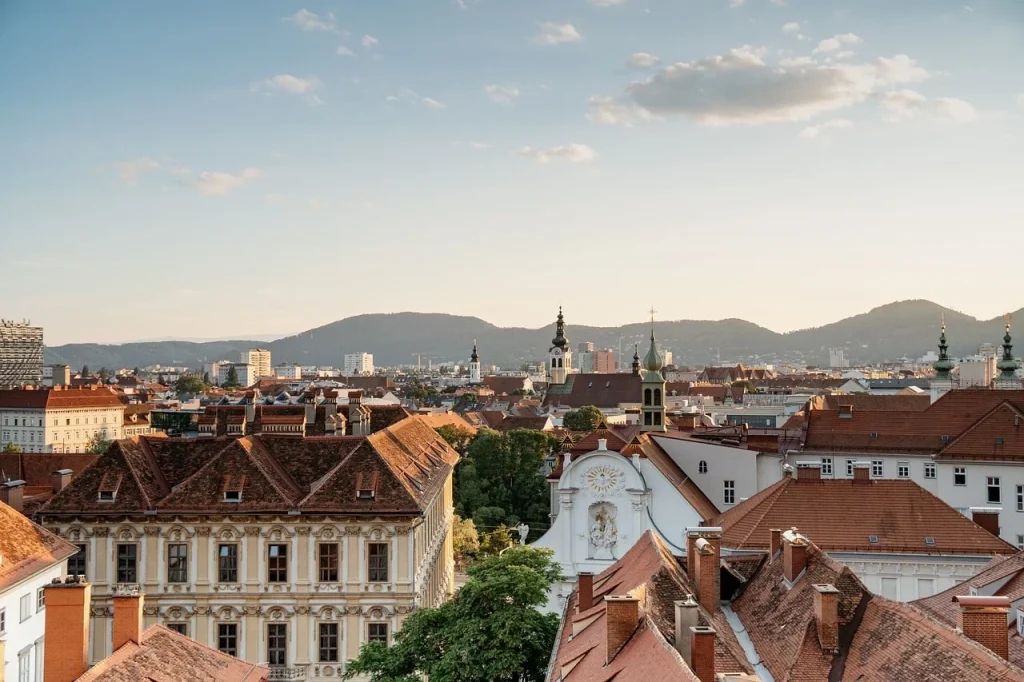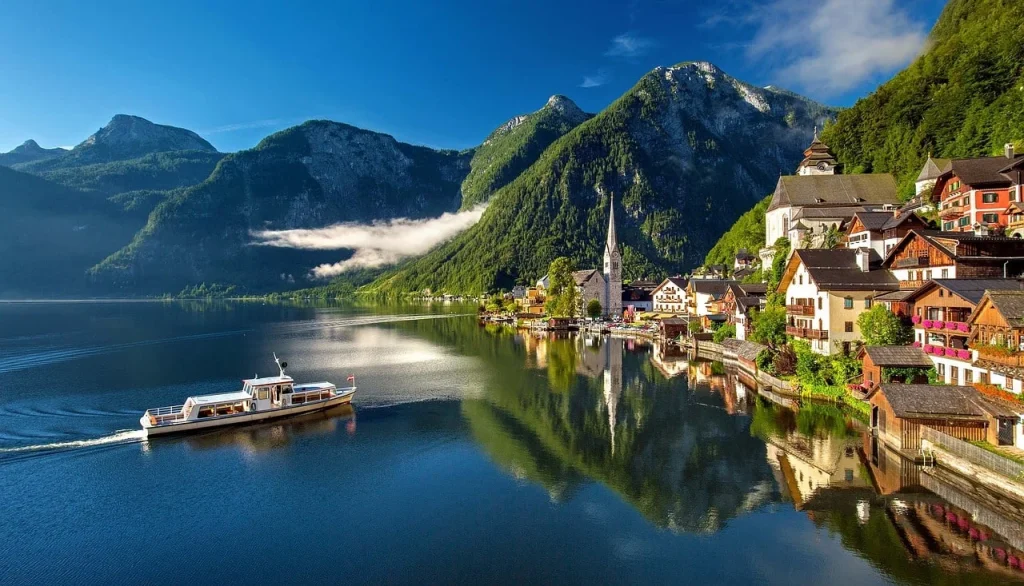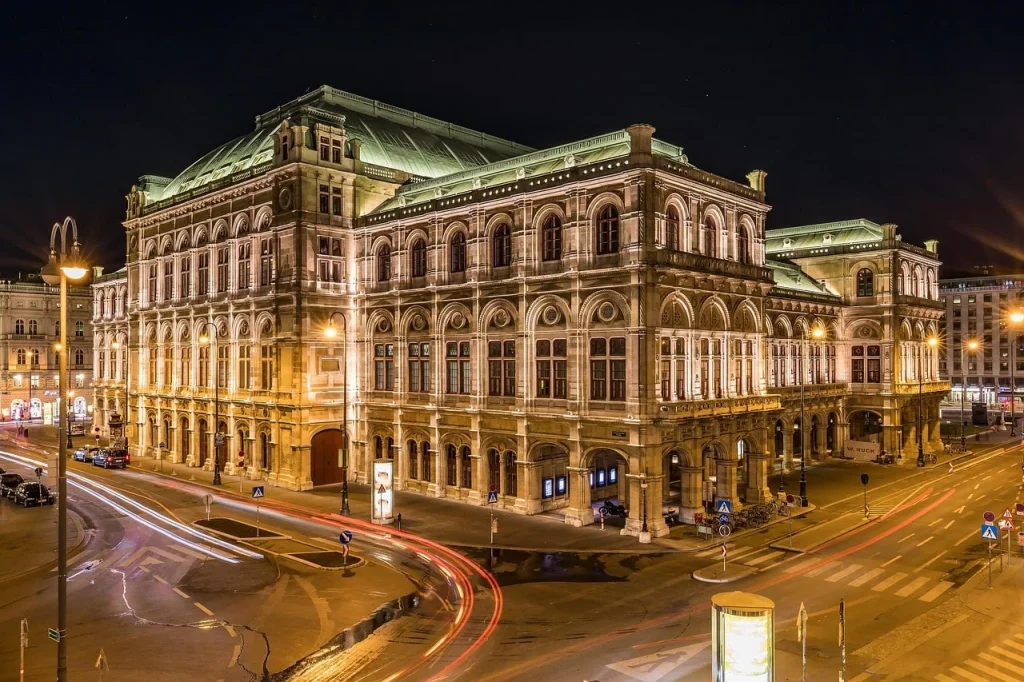Welcome to Austria, a country renowned for its picturesque landscapes and vibrant cultural scene! Did you know that Austria is the birthplace of famous composers like Mozart and Strauss?
We’ll read some interesting facts about Austria, exploring everything from its historic cities and famous citizens to its culinary delights and influential art.
To the left Vienna, to the right Budapest, ahead of us the Balkans, behind us many troubles.
Emperor Franz Joseph I
Austria Facts
Explore the amazing facts about Austria, a country full of surprises and rich traditions. Stay sharp, as a quiz at the end will test how well you’ve learned about this nation!
- Vienna’s Zentralfriedhof is one of the largest cemeteries in the world, hosting graves of over 3 million people, including famous composers like Beethoven and Brahms.
- The world’s oldest zoo, Tiergarten Schönbrunn, opened in 1752 and is still operating in Vienna.
- Austria is home to the world’s largest ice cave, Eisriesenwelt, stretching over 42 kilometers.
- Wiener Neustadt hosts the world’s oldest known prisoner-of-war camp, dating back to the 18th century.
- The Arnold Schwarzenegger Museum in Thal showcases the actor and former governor’s life, complete with his first barbell and a replica of his office.
- The first documented snow globe was created in Vienna by Erwin Perzy I in 1900.
- Vienna’s Hofburg Palace has 2,600 rooms and covers 240,000 square meters, making it one of the largest palace complexes in the world.
- The Starkenberger Brewery has beer swimming pools, where you can bathe in warm, non-alcoholic beer.
- Salzburg’s “Sound of Music” Pavilion, used in the famous movie, is located in Hellbrunn Palace Gardens.
- The Semmering Railway, opened in 1854, was the first mountain railway in Europe and a UNESCO World Heritage Site.
- Austria boasts over 25,000 castles, palaces, and stately homes, with some available for overnight stays.
- Vienna’s Prater amusement park features the world’s oldest operating Ferris wheel, built in 1897.
- The Swarovski Crystal Worlds museum in Wattens showcases dazzling crystal art installations and exhibitions.

- Austria has the highest per capita consumption of organic products in the European Union.
- The world’s smallest national park, Thayatal National Park, spans only 1,330 hectares and is shared with the Czech Republic.
- Vienna’s Coffee House Culture is UNESCO recognized for its unique social and cultural significance.
- The Lipizzaner horses of the Spanish Riding School in Vienna trace their ancestry back to the 16th century.
- The Krimml Waterfalls in the Hohe Tauern National Park are the highest in Europe, with a total drop of 380 meters.
- The Seegrotte Hinterbrühl is an underground lake formed by a mining accident and is one of the largest underground lakes in Europe.
- The Steyr Automobile Works produced the first fully functional six-cylinder engine in 1929.
- The world’s largest emerald, weighing 2,860 carats, is displayed in Vienna’s Imperial Treasury.
- The Silent Night Chapel in Oberndorf stands on the site where the famous Christmas carol “Silent Night” was first performed in 1818.
- The Viennese Ball Season includes over 450 balls annually, drawing thousands of visitors from around the world.
- The Augustinian monks at the Klosterneuburg Monastery produce Austria’s oldest wine, dating back over 900 years.
- The Zillertal Railway is one of the world’s last remaining steam-powered narrow-gauge railways.
- The Glockengießerei Grassmayr in Innsbruck has been producing bells for over 400 years.
- The Habsburg Empire’s influence brought over 640 years of stability and prosperity to the region.
- Vienna was the first city to adopt the title “World Capital of Music,” boasting residents like Mozart, Beethoven, and Haydn.

- The word “quarantine” originated from the Austrian practice of isolating plague patients for 40 days in the 14th century.
- The Vienna Philharmonic’s New Year’s Concert is one of the most-watched events worldwide, broadcast to over 90 countries.
- Austria’s Red Bull brand revolutionized the energy drink market and is now a global phenomenon.
- The Schönbrunn Palace’s Great Gallery served as the setting for the signing of the Austrian State Treaty in 1955.
- The Danube Island Festival in Vienna is Europe’s largest free open-air festival, attracting over 3 million visitors annually.
- The Grüner See in Styria disappears in winter and reappears in spring, creating a stunning underwater park.
- The medieval city of Hallstatt is so picturesque that China created a replica of it in Guangdong Province.
- The Belvedere Museum in Vienna houses the largest collection of Gustav Klimt’s paintings, including “The Kiss.”
- The Austrian village of Fucking gained international fame due to its name and eventually changed it to Fugging in 2021.
- The Grossglockner High Alpine Road offers breathtaking views of Austria’s highest peak, Grossglockner, standing at 3,798 meters.

- The Melk Abbey is a masterpiece of Baroque architecture and has been a spiritual and cultural center for over 900 years.
- The Vienna Boys’ Choir, one of the oldest boys’ choirs in the world, dates back to 1498.
- The Seefeld Plateau hosted the Winter Olympics twice, in 1964 and 1976, showcasing world-class skiing facilities.
- The Vienna Ring Road (Ringstrasse) is considered one of the most beautiful boulevards in the world, encircling the city’s historic center.
- The Bregenzer Festspiele stages elaborate opera performances on a floating stage on Lake Constance, attracting international acclaim.
- The Arlberg region is known as the “Cradle of Alpine Skiing,” where modern skiing techniques were developed in the early 20th century.
- The Kunsthistorisches Museum in Vienna houses one of the largest collections of art and antiquities in the world.
- The Giant Ferris Wheel in Vienna’s Prater Park was the tallest in the world when it was constructed in 1897.
- Vienna’s Imperial Butterfly House (Schmetterlinghaus) hosts hundreds of tropical butterflies in a historic Art Nouveau greenhouse.
- The Austrian Postal Savings Bank, designed by Otto Wagner, is a masterpiece of early modern architecture.
- The town of Gmunden is famous for its unique ceramic bells, handcrafted for centuries and still popular today.
- The Pasterze Glacier is Austria’s longest glacier, stretching over 8 kilometers at the foot of Grossglockner.
Austria Myths

Now that we’ve explored the facts about Austria, let’s continue into the myths. It’s time to separate what’s true from what’s merely folklore.
- Everyone in Austria Speaks German
While German is the official language of Austria, many Austrians are multilingual. Besides German, significant portions of the population speak Turkish, Serbian, and Croatian. Austria’s rich cultural tapestry includes multiple languages, reflecting its diverse society. - Austria Is All About Classical Music and Opera
Austria does cherish its classical music heritage, with icons like Mozart and Beethoven. However, contemporary music scenes, especially in cities like Vienna and Graz, are vibrant and diverse, encompassing everything from rock to electronic music. - Austrians Are Reserved and Unfriendly
Austrians might appear reserved at first. However, once you get to know them, they’re incredibly warm and welcoming. Friendliness in Austria is often shown through gestures of hospitality and a willingness to share local customs. - Austria Is Just Mountains
While the Alps cover a significant part of Austria, the country also boasts beautiful plains, lakes, and rivers. The eastern region, for example, features extensive vineyards and flat landscapes, offering a different kind of natural beauty. - Austrian Cuisine Is Limited to Meat and Potatoes
Austrian cuisine is much more diverse. While meat dishes like Wiener Schnitzel are famous, Austria also offers a variety of pastries, vegetarian dishes, and influences from neighboring countries, making its food scene rich and varied.
Austria Quotes

We continue with the quotes. Feel free to share more with me in the comments and I will add them to the list.
Vienna is a handsome, lively city, and pleases me exceedingly.
Frederic Chopin
The renowned Polish composer Frederic Chopin expressed his fondness for Vienna’s vibrant culture and aesthetic beauty during his visits in the 19th century.
If the world ever recovers, it will be through the schools of Austria.
Thomas Jefferson
U.S. President Thomas Jefferson admired Austria’s educational system, emphasizing its potential global influence in this praise.
Austria is a little world, in which the big one holds its tryouts.
Joseph Roth
This metaphor by Joseph Roth, an Austrian journalist and novelist, highlights Austria’s role as a microcosm for broader global trends and movements.
Austria is that rare blend of the ancient and the modern which adds a new flavor to life.
Emma Lazarus
American poet Emma Lazarus remarked on the unique mix of historical depth and modernity found in Austria, which she believed enriched life’s experiences.
Austria: The lungs of Europe.
Sir Edward Bulwer-Lytton
British writer Sir Edward Bulwer-Lytton poetically described Austria’s vast forests and natural beauty as being vital to the continent, much like lungs to a body.
Austria FAQ

Before you challenge yourself with our quiz, let’s continue with the FAQ section. Read carefully if you want to score a perfect ten.
- What is the capital of Austria?
Vienna is the capital of Austria. It’s known for its cultural heritage, including music, art, and architecture. - What languages are spoken in Austria?
The official language is German. However, you’ll also hear other languages like Turkish, Serbian, and Croatian in multicultural areas. - What are some must-visit places in Austria?
Some must-visit places include Salzburg, the birthplace of Mozart, the scenic Alpine region of Tyrol, and the historic Schönbrunn Palace in Vienna. - What is a traditional Austrian dish?
Wiener Schnitzel is a famous Austrian dish. It’s a breaded and fried veal or pork cutlet, often served with a slice of lemon and parsley potatoes. - How does Austria handle public transportation?
Austria boasts an efficient public transportation network. Trains and buses are punctual and cover most regions, making it easy to get around both urban and rural areas.
Austria Trivia

Welcome to our Austrian quiz! Remember, if you don’t score a point, you might find yourself yodeling for help in the Alps!
Conclusion
In closing, Austria stands as a beacon of cultural richness and scenic splendor. The historical narratives and artistic achievements discussed in this article illustrate a nation that values both preservation and innovation.
Whether it’s the solemn history of Vienna or the lively festivities of Salzburg, Austria offers a unique blend of the past and the present. Till next time, stay curious and explore more. Cheers.


